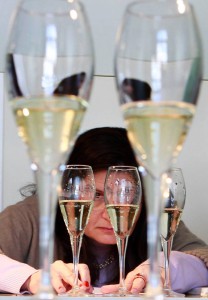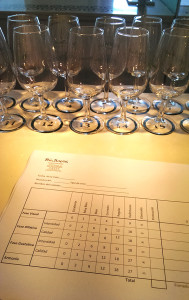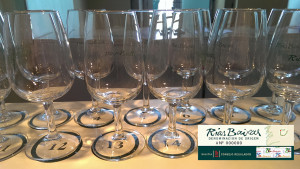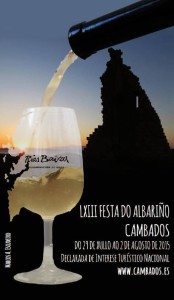[:en]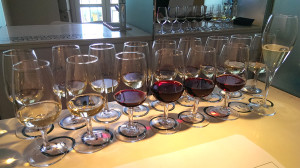 On a couple of occasions now I have been lucky enough to attend an official tasting – but purely as a guest with absolutely no input into the final outcome. It can be very “interesting”!
On a couple of occasions now I have been lucky enough to attend an official tasting – but purely as a guest with absolutely no input into the final outcome. It can be very “interesting”!
Now there was a time in my life as a buyer, that I was tasting different wines from around the globe on a daily basis – often in fairly copious amounts (without swallowing I hasten to add!) These days however, my tasting, although reasonably regular, is often restricted to our own wines, within our own cellar. Of course this might eventually distort the palate a little, as you become more accustomed to, and able to easily recognise your own style of wine. I’m afraid that the opportunity to taste overseas wine these days is fairly restricted as they are simply not available in Galician shops, albeit there are one or two online shops where I can find an odd bottle or two.
Prior to the start of the tasting the only information that you are given is the type, classification and vintage of the wine. When I say classification it can be any one of the following:
- Rias Baixas ALBARIÑO
- Rias Baixas CONDADO DO TEA
- Rias Baixas ROSAL
- Rias Baixas DO ULLA
- Rias Baixas SALNES
- Rias Baixas
- Rias Baixas BARRICA
- Rias Baixas TINTO
- Rias Baixas SPARKLING
I mentioned this in my last post but a wine can only be called albariño if it comprises 100% of that variety – any other blend, even if it only 1% of another grape can only be known as a Rias Baixas wine. Any wine can then also carry the name of its sub-zone if the bodega so chooses. (An albariño wine (100%) can also carry the name of its sub-zone).
Of course, the idea is not really to criticise or comment too much on any one wine, but simply to rate it on its technical merits and quality. The key is of course to remain objective and aloof, but when most of my tasting experience in the past has been comparative, judging one wine next to another to select the best, then this does not come easily, and it is only human nature, in these circumstances, to use your own wine as a yardstick.
On this occasion we were offered the maximum permitted of 15 wines – one sparkling, four tintos and the rest white, mostly 100% albariño. The selection included two 2015 wines, which I admit, came as quite a shock, barely more than one month after the last day of picking in our denomination.
Of course I cannot comment about specific wines, but suffice to say that it was a mixed bag – some good, some bad and at least one downright ugly! The white wines of 2014 were generally acceptable, whilst one of the 2015’s showed all the typical character of what I call a ‘primeur’ wine – vinified quickly, massively fruity, but I am sure with only a very short shelf life – drink now and enjoy while you can! It had a very exotic, almost banana, sweet pear drop fruit that I would normally associate with Beaujolais nouveau rather than a young albariño (very appropriate on today of all days)! This sensation probably originates from the same ester called isoamyl acetate (which is sometimes formed during low temperature fermentations and carbonic maceration depending on the type of yeast used).
The one ‘barrica’ wine on show was, erm…. poor, to say the least. Heaven only knows what type of wood was employed in the making of this wine, but I wrote in my notes that it had a bouquet of beetroot! (Not a usual attribute of albariño). Finally, the majority of reds on offer gave the impression of being a bit green and under-ripe, and thankfully I think the panel agreed with me as I don’t think that any single tinto passed the tasting.
It wasn’t my first D.O. tasting as a guest, and I hope it won’t be my last, but it certainly was a bit of an eye-opener.[:es] On a couple of occasions now I have been lucky enough to attend an official tasting – but purely as a guest with absolutely no input into the final outcome. It can be very “interesting”!
On a couple of occasions now I have been lucky enough to attend an official tasting – but purely as a guest with absolutely no input into the final outcome. It can be very “interesting”!
Now there was a time in my life as a buyer, that I was tasting different wines from around the globe on a daily basis – often in fairly copious amounts (without swallowing I hasten to add!) These days however, my tasting, although reasonably regular, is often restricted to our own wines, within our own cellar. Of course this might eventually distort the palate a little, as you become more accustomed to, and able to easily recognise your own style of wine. I’m afraid that the opportunity to taste overseas wine these days is fairly restricted as they are simply not available in Galician shops, albeit there are one or two online shops where I can find an odd bottle or two.
Prior to the start of the tasting the only information that you are given is the type, classification and vintage of the wine. When I say classification it can be any one of the following:
- Rias Baixas ALBARIÑO
- Rias Baixas CONDADO DO TEA
- Rias Baixas ROSAL
- Rias Baixas DO ULLA
- Rias Baixas SALNES
- Rias Baixas
- Rias Baixas BARRICA
- Rias Baixas TINTO
- Rias Baixas SPARKLING
I mentioned this in my last post but a wine can only be called albariño if it comprises 100% of that variety – any other blend, even if it only 1% of another grape can only be known as a Rias Baixas wine. Any wine can then also carry the name of its sub-zone if the bodega so chooses. (An albariño wine (100%) can also carry the name of its sub-zone).
Of course, the idea is not really to criticise or comment too much on any one wine, but simply to rate it on its technical merits and quality. The key is of course to remain objective and aloof, but when most of my tasting experience in the past has been comparative, judging one wine next to another to select the best, then this does not come easily, and it is only human nature, in these circumstances, to use your own wine as a yardstick.
On this occasion we were offered the maximum permitted of 15 wines – one sparkling, four tintos and the rest white, mostly 100% albariño. The selection included two 2015 wines, which I admit, came as quite a shock, barely more than one month after the last day of picking in our denomination.
Of course I cannot comment about specific wines, but suffice to say that it was a mixed bag – some good, some bad and at least one downright ugly! The white wines of 2014 were generally acceptable, whilst one of the 2015’s showed all the typical character of what I call a ‘primeur’ wine – vinified quickly, massively fruity, but I am sure with only a very short shelf life – drink now and enjoy while you can! It had a very exotic, almost banana, sweet pear drop fruit that I would normally associate with Beaujolais nouveau rather than a young albariño (very appropriate on today of all days)! This sensation probably originates from the same ester called isoamyl acetate (which is sometimes formed during low temperature fermentations and carbonic maceration depending on the type of yeast used).
The one ‘barrica’ wine on show was, erm…. poor, to say the least. Heaven only knows what type of wood was employed in the making of this wine, but I wrote in my notes that it had a bouquet of beetroot! (Not a usual attribute of albariño). Finally, the majority of reds on offer gave the impression of being a bit green and under-ripe, and thankfully I think the panel agreed with me as I don’t think that any single tinto passed the tasting.
It wasn’t my first D.O. tasting as a guest, and I hope it won’t be my last, but it certainly was a bit of an eye-opener.[:]
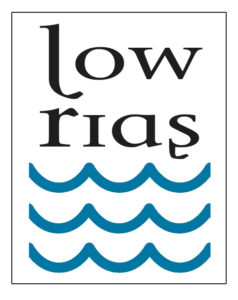 Behind the scenes in certain Galician offices there have been some, more or less, secret discussions. Apparently, for the last couple of years, our denomination have been discussing the idea of renaming our very own wine region – Rias Baixas. Their concern has been that many consumers outside Spain are a bit intimidated by the name, especially when it comes to the pronunciation. Of course, the word Albariño is comparatively simple for most people to wrap their tongue around, but when it come to our ‘lower estuaries’, then it becomes more of a problem.
Behind the scenes in certain Galician offices there have been some, more or less, secret discussions. Apparently, for the last couple of years, our denomination have been discussing the idea of renaming our very own wine region – Rias Baixas. Their concern has been that many consumers outside Spain are a bit intimidated by the name, especially when it comes to the pronunciation. Of course, the word Albariño is comparatively simple for most people to wrap their tongue around, but when it come to our ‘lower estuaries’, then it becomes more of a problem.




